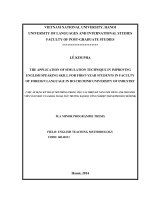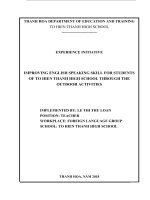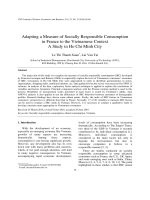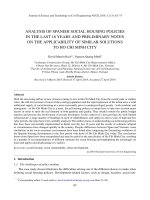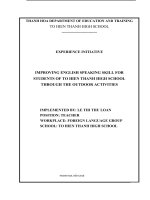THE APPLICATION OF SIMULATION TECHNIQUE IN IMPROVING ENGLISH SPEAKING SKILL FOR FIRST-YEAR STUDENTS IN FACULTY OF FOREIGN LANGUAGE IN HO CHI MINH UNIVERSITY OF INDUSTRY
Bạn đang xem bản rút gọn của tài liệu. Xem và tải ngay bản đầy đủ của tài liệu tại đây (1.52 MB, 93 trang )
VIETNAM NATIONAL UNIVERSITY, HANOI
UNIVERSITY OF LANGUAGES AND INTERNATIONAL STUDIES
FACULTY OF POST-GRADUATE STUDIES
*********************
LÊ KIM PHA
THE APPLICATION OF SIMULATION TECHNIQUE IN IMPROVING
ENGLISH SPEAKING SKILL FOR FIRST-YEAR STUDENTS IN FACULTY
OF FOREIGN LANGUAGE IN HO CHI MINH UNIVERSITY OF INDUSTRY
(VIỆC ÁP DỤNG KỸ THUẬT MƠ PHỎNG TRONG VIỆC CẢI THIỆN KỸ NĂNG NĨI TIẾNG ANH CHO SINH
VIÊN NĂM NHẤT CỦA KHOA NGOẠI NGỮ TRƯỜNG ĐẠI HỌC CƠNG NGHIỆP THÀNH PHỐ HỒ CHÍ MINH)
M.A MINOR PROGRAMME THESIS
FIELD: ENGLISH TEACHING METHODOLOGY
CODE: 60140111
Hanoi, 2014
VIETNAM NATIONAL UNIVERSITY, HANOI
UNIVERSITY OF LANGUAGES AND INTERNATIONAL STUDIES
FACULTY OF POST-GRADUATE STUDIES
*********************
LÊ KIM PHA
THE APPLICATION OF SIMULATION TECHNIQUE IN IMPROVING
ENGLISH SPEAKING SKILL FOR FIRST-YEAR STUDENTS IN
FACULTY OF FOREIGN LANGUAGE IN HO CHI MINH UNIVERSITY
OF INDUSTRY
(VIỆC ÁP DỤNG KỸ THUẬT MÔ PHỎNG TRONG VIỆC CẢI THIỆN KỸ NĂNG NÓI TIẾNG ANH CHO SINH
VIÊN NĂM NHẤT CỦA KHOA NGOẠI NGỮ TRƯỜNG ĐẠI HỌC CƠNG NGHIỆP THÀNH PHỐ HỒ CHÍ MINH)
M.A MINOR PROGRAMME THESIS
FIELD: ENGLISH TEACHING METHODOLOGY
CODE: 60140111
SUPERVISOR: PHẠM HỮU ĐỨC, PhD.
Hanoi, 2014
DECLARATION OF AUTHORSHIP
I, Lê Kim Pha, declare that this graduation thesis is original and has not been submitted
for assessment elsewhere.
I declare that this assignment is my own work and does not involve plagiarism or
collusion.
I give my consent for the electronic version to be examined by relevant plagiarism
software programs.
I have made a photocopy or electronic copy of my assignment, which I can produce if
the original is lost for any reason.
Date: … / … / 2014
Signature
Lê Kim Pha
i
ACKNOWLEDGEMENTS
First and foremost, I would like to send my deepest gratitude to my advisor, Dr.
Phạm Hữu Đức, for his encouragement, dedicated guidance and constant assistance
from the initial stage to the final stage to develop an understanding of the subject,
without which this thesis would not have been possible. I would also like to express my
hearty thanks for his spending precious family time on my call at any time.
It is my pleasure to thank the teachers of class DHAV9A and DHAV9B; Ms.
Hoàng Lê Thị Tuyết and Ms. Lê Ngọc Diệp who facilitated me the most in the delivery
of questionnaires and observation of the students‟ activities.
I would like to thank the students of class DHAV9, NCAV7 who helped me
pilot as well as fulfilled the questionnaires and interviews.
My warm gratitude goes to my family who always believes in me, always
respects my choices and gives me the best support both of spirit and finance.
Above all, I thank God, who blesses me with peaceful energy to support me at
all time.
ii
ABSTRACT
There is no doubt about the significance of English in today‟s world when the
communicative abilities become important. And one of the challenges is that how to
help student be able to apply their classroom knowledge in real-life situations to the
most extent. Simulation is considered as one of the potential activities to wed theory
into practice and improve students‟ speaking skills.
The attempt was to know whether students were engaged in simulation and their
responses to this activity. To serve these purposes, a quantitative research together with
a specific group of 59 first-year students was chosen. At the same time, two phases of
questionnaires, before introducing simulation and after its implementation were
proceeded. For the achievements of these purposes, besides 59 freshmen from
DHAV9A, DHAV9B, more methodologies including questionnaires and the interviews
were also employed to help the researcher examine and provide more details to the
findings as statistics and reliable materials for the analyzing phase.
The results have found students‟ interest and support for this kind of activities.
They got chances to deal with realistic situations in relaxing settings, which not only
prepared them with practical experience but promised to contribute to the improvement
of
their
speaking
skills.
Additionally,
this
paper
also
provided
several
recommendations for the implementation of simulation, which were withdrawn from
the research process.
iii
TABLE OF CONTENTS
DECLARATION OF AUTHORSHIP……………………………………………….i
ACKNOWLEDGEMENTS………………………………………………………....ii
ABSTRACT ……………………………………………………………………….iii
TABLE OF CONTENTS…………………………………………………………...iv
LIST OF ABBREVIATIONS…………………………………………………….viii
LIST OF TABLES AND FIGURES……………………………………………….ix
PART A: INTRODUCTION
1. Rationale ················································································1
2. Aims and objectives of the study ····················································2
3. Research questions ····································································2
4. Scope of the study ·····································································3
5. Methods ·················································································3
6. Organization of the study·····························································4
PART B: DEVELOPMENT
CHAPTER 1: LITERATURE REVIEW
1.1. Simulations ············································································5
1.1.1. Definition of simulations in language learning context ··················5
1.1.2. Characteristics of simulations ···············································6
1.1.3. Distinction simulations and role-plays ·····································8
1.1.4. Distinction simulations and games ········································ 10
1.1.5. The role of simulations in L2 teaching and learning context ·········· 11
1.1.6. The limitation of simulations ·············································· 12
iv
1.1.7. The effects of simulations on students‟ attitudes in language learning
……………………………………………………………………….13
1.1.7.1. Motivation ····························································· 13
1.1.7.2. Activeness ····························································· 14
1.1.7.3. Courage and confidence ············································· 15
1.2. Summary of previous studies on simulations in language teaching and learning
· 16
CHAPTER 2: METHODOLOGY
2.1. Participants and setting of the study ············································· 18
2.2. Data collection ······································································ 18
2.2.1. Data collection instruments ·············································· 18
2.2.1.1.
Questionnaire ························································ 18
2.2.1.2.
Interview ····························································· 19
2.2.2. Data collection procedures ················································· 19
2.2.2.1.
Piloting ······························································· 19
a)
Piloting the questionnaires ········································· 19
b)
Piloting the interview ··············································· 20
2.2.2.2.
Main procedure ······················································ 20
2.2.3. Data analysis procedures ··················································· 21
CHAPTER 3: FINDINGS AND DISCUSSION
3.1. Findings and discussion ··························································· 23
3.1.1. Students‟ English speaking learning before the introduction of
simulations ····································································· 23
3.1.1.1.
Students‟ attitudes in general towards the current speaking
activities at class ························································· 23
v
3.1.1.2.
Students‟ improvement of speaking skills in comparison with that
of the last semester ······················································ 25
3.1.1.3.
Students‟ frequency in practicing English speaking skills in daily
situations ·································································· 25
3.1.1.4.
Students‟ confidence in bringing English to realistic conversations
with native speakers ····················································· 26
3.1.1.5.
Students‟ participation in a variety of activities ················ 28
3.1.1.6.
The activities that students feel like to participate in most ···· 29
3.1.1.7.
Students‟ choice among various activities: group discussion, class
discussion, role play and simulations ································· 30
3.1.1.8.
Students‟ expectations in their speaking class ·················· 31
3.1.2. The implementation and students‟ responses towards simulations ··· 33
3.1.2.1.
Students‟ interest in simulations ·································· 33
3.1.2.2.
Students‟ responses about the benefits of simulations ········· 35
3.1.2.3.
Students‟ self-evaluation about their roles in the simulations 37
3.1.2.4.
Comparison of students‟ attitudes among various speaking
activities ··································································· 38
3.1.2.5.
Do the students want simulations to be employed? ············ 39
3.2. Pedagogical implications ·························································· 39
PART C: CONCLUSION
1. Recapitulation of the study ························································· 41
2. Conclusions of the study ··························································· 41
3. Limitations of the study ···························································· 42
4. Suggestions for further study ······················································ 43
REFERENCES ··············································································· 45
vi
APPENDICES
Appendix 1:Table 1: Simulation vs. Role play ........................................................ I
Appendix 2: Table 2: Simulation vs. Game ·············································· II
Appendix 3: Table 3: Summary of previous studies on simulation ··················· III
Appendix 4: Table 4: The practice of speaking skills in real –life situations ······· V
Appendix 5: Table 5: Students‟ confidence in communicating with native speakers.
·································································································· VI
Appendix 6: Table 6: Students‟ participation in various types of activities………VII
Appendix 7: Table 7: The activities that students feel like to participate in
most………………………………………………………………………………VIII
Appendix 8: Table 8: Comparison of students‟ attitudes among various speaking
activities. ······················································································ IX
Appendix 9: Schedule of classroom observation …………………………………..X
Appendix 10: Questionnaire 1 (English version) Speaking activities in classroom
before the application of simulations ····················································· XI
Appendix 11: Questionnaire 1 (Viet version) Quan sát hoạt động trong tiết học
speaking…………………………………………………………………………..XIII
Appendix 12: Questionnaire 2 (English version) Students‟ attitudes and responses to
simulations ·················································································· XV
Appendix 13: Questionnaire 2 (Viet version) Quan sát thái độ của sinh viên về
simulations ················································································· XVII
Appendix 14: Sample lesson plan 1 - Shopping Stands…………………………XIX
Appendix 16: Lesson plan 2 - Restaurant Servicesimulations: Making and taking order
in a restaurant ············································································· XXI
vii
LIST OF ABBREVIATIONS
FFL
: Faculty of Foreign Language
HUI
: Ho Chi Minh University of Industry
DHAV9
: Đại học Anh văn 9
L2
: Second Language
viii
LIST OF TABLES AND FIGURES
Table 1: Simulation vs. Role play
Table 2: Simulation vs. Game
Table 3: Summary of previous studies on simulation
Table 4: The practice of speaking skills in real –life situations
Table 5: Students‟ confidence in communicating with native speakers
Table 6: Students‟ participation in various types of activities
Table 7: The activities that students feel like to participate in most
Table 8: Comparison of students‟ attitudes among various speaking activities
Figure 1: The structure of a simulation
Figure 2: Students‟ attitudes on speaking activities
Figure 3: Students‟ improvement of speaking skills compared to the last semester
Figure 4: The practice of speaking skills in real-life situations
Figure 5: Students‟ confidence in communicating with native speakers
Figure 6: Students‟ participation in various types of activities
Figure 7: The activities that students feel like to participate in most
Figure 8: Students‟ choice among discussion, role play and simulation
Figure 8: Students‟ interest in simulation
Figure 10: Students‟ responses about the benefits of simulation
Figure 11: Comparison of students‟ attitudes among various speaking activities
ix
DECLARATION OF AUTHORSHIP
I, Lê Kim Pha, declare that this graduation thesis is original and has not been submitted
for assessment elsewhere.
I declare that this assignment is my own work and does not involve plagiarism or
collusion.
I give my consent for the electronic version to be examined by relevant plagiarism
software programs.
I have made a photocopy or electronic copy of my assignment, which I can produce if
the original is lost for any reason.
Date: … / … / 2014
Signature
Lê Kim Pha
x
ACKNOWLEDGEMENTS
First and foremost, I would like to send my deepest gratitude to my advisor, Dr.
Phạm Hữu Đức, for his encouragement, dedicated guidance and constant assistance
from the initial stage to the final stage to develop an understanding of the subject,
without which this thesis would not have been possible. I would also like to express my
hearty thanks for his spending precious family time on my call at any time.
It is my pleasure to thank the teachers of class DHAV9A and DHAV9B; Ms.
Hoàng Lê Thị Tuyết and Ms. Lê Ngọc Diệp who facilitated me the most in the delivery
of questionnaires and observation of the students‟ activities.
I would like to thank the students of class DHAV9, NCAV7 who helped me
pilot as well as fulfilled the questionnaires and interviews.
My warm gratitude goes to my family who always believes in me, always
respects my choices and gives me the best support both of spirit and finance.
Above all, I thank God, who blesses me with peaceful energy to support me at
all time.
xi
ABSTRACT
There is no doubt about the significance of English in today‟s world when the
communicative abilities become important. And one of the challenges is that how to
help student be able to apply their classroom knowledge in real-life situations to the
most extent. Simulation is considered as one of the potential activities to wed theory
into practice and improve students‟ speaking skills.
The attempt was to know whether students were engaged in simulation and their
responses to this activity. To serve these purposes, a quantitative research together with
a specific group of 59 first-year students was chosen. At the same time, two phases of
questionnaires, before introducing simulation and after its implementation were
proceeded. For the achievements of these purposes, besides 59 freshmen from
DHAV9A, DHAV9B, more methodologies including questionnaires and the interviews
were also employed to help the researcher examine and provide more details to the
findings as statistics and reliable materials for the analyzing phase.
The results have found students‟ interest and support for this kind of activities.
They got chances to deal with realistic situations in relaxing settings, which not only
prepared them with practical experience but promised to contribute to the improvement
of
their
speaking
skills.
Additionally,
this
paper
also
provided
several
recommendations for the implementation of simulation, which were withdrawn from
the research process.
xii
TABLE OF CONTENTS
DECLARATION OF AUTHORSHIP……………………………………………….i
ACKNOWLEDGEMENTS………………………………………………………....ii
ABSTRACT ……………………………………………………………………….iii
TABLE OF CONTENTS…………………………………………………………...iv
LIST OF ABBREVIATIONS…………………………………………………….viii
LIST OF TABLES AND FIGURES……………………………………………….ix
PART A: INTRODUCTION
7. Rationale ················································································1
8. Aims and objectives of the study ····················································2
9. Research questions ····································································2
10. Scope of the study ·····································································3
11. Methods ·················································································3
12. Organization of the study·····························································4
PART B: DEVELOPMENT
CHAPTER 1: LITERATURE REVIEW
1.3. Simulations ············································································5
1.1.8. Definition of simulations in language learning context ·················5
1.1.9. Characteristics of simulations ···············································6
1.1.10. ···················································································Dist
inction simulations and role-plays·············································8
1.1.11. ················································································· Disti
nction simulations and games ················································ 10
xiii
1.1.12. ················································································· The
role of simulations in L2 teaching and learning context ················· 11
1.1.13. ················································································· The
limitation of simulations ······················································ 12
1.1.14.The effects of simulations on students‟ attitudes in language learning
……………………………………………………………………….13
1.1.7.4. Motivation ····························································· 13
1.1.7.5. Activeness ····························································· 14
1.1.7.6. Courage and confidence ············································· 15
1.4. Summary of previous studies on simulations in language teaching and learning
· 16
CHAPTER 2: METHODOLOGY
2.3. Participants and setting of the study ············································· 18
2.4. Data collection ······································································ 18
2.2.4. Data collection instruments ·············································· 18
2.2.1.3.
Questionnaire ························································ 18
2.2.1.4.
Interview ····························································· 19
2.2.5. Data collection procedures ················································· 19
2.2.2.3.
Piloting ······························································· 19
c)
Piloting the questionnaires ········································· 19
d)
Piloting the interview ··············································· 20
2.2.2.4.
Main procedure ······················································ 20
2.2.6. Data analysis procedures ··················································· 21
CHAPTER 3: FINDINGS AND DISCUSSION
3.3. Findings and discussion ··························································· 23
xiv
3.1.3. Students‟ English speaking learning before the introduction of
simulations ····································································· 23
3.1.1.9.
Students‟ attitudes in general towards the current speaking
activities at class ························································· 23
3.1.1.10. Students‟ improvement of speaking skills in comparison with that
of the last semester ······················································ 25
3.1.1.11. Students‟ frequency in practicing English speaking skills in daily
situations ·································································· 25
3.1.1.12. Students‟ confidence in bringing English to realistic conversations
with native speakers ····················································· 26
3.1.1.13. Students‟ participation in a variety of activities ················ 28
3.1.1.14. The activities that students feel like to participate in most ···· 29
3.1.1.15. Students‟ choice among various activities: group discussion, class
discussion, role play and simulations ································· 30
3.1.1.16. Students‟ expectations in their speaking class ·················· 31
3.1.4. The implementation and students‟ responses towards simulations ··· 33
3.1.2.6.
Students‟ interest in simulations ·································· 33
3.1.2.7.
Students‟ responses about the benefits of simulations ········· 35
3.1.2.8.
Students‟ self-evaluation about their roles in the simulations 37
3.1.2.9.
Comparison of students‟ attitudes among various speaking
activities ··································································· 38
3.1.2.10. Do the students want simulations to be employed? ············ 39
3.4. Pedagogical implications ·························································· 39
PART C: CONCLUSION
5. Recapitulation of the study ························································· 41
6. Conclusions of the study ··························································· 41
xv
7. Limitations of the study ···························································· 42
8. Suggestions for further study ······················································ 43
REFERENCES ··············································································· 45
APPENDICES
Appendix 1:Table 1: Simulation vs. Role play ........................................................ I
Appendix 2: Table 2: Simulation vs. Game ·············································· II
Appendix 3: Table 3: Summary of previous studies on simulation ··················· III
Appendix 4: Table 4: The practice of speaking skills in real –life situations ······· V
Appendix 5: Table 5: Students‟ confidence in communicating with native speakers.
·································································································· VI
Appendix 6: Table 6: Students‟ participation in various types of activities………VII
Appendix 7: Table 7: The activities that students feel like to participate in
most………………………………………………………………………………VIII
Appendix 8: Table 8: Comparison of students‟ attitudes among various speaking
activities. ······················································································ IX
Appendix 9: Schedule of classroom observation …………………………………..X
Appendix 10: Questionnaire 1 (English version) Speaking activities in classroom
before the application of simulations ····················································· XI
Appendix 11: Questionnaire 1 (Viet version) Quan sát hoạt động trong tiết học
speaking…………………………………………………………………………..XIII
Appendix 12: Questionnaire 2 (English version) Students‟ attitudes and responses to
simulations ·················································································· XV
Appendix 13: Questionnaire 2 (Viet version) Quan sát thái độ của sinh viên về
simulations ················································································· XVII
Appendix 14: Sample lesson plan 1 - Shopping Stands…………………………XIX
Appendix 16: Lesson plan 2 - Restaurant Service simulations: Making and taking order
in a restaurant ············································································· XXI
xvi
LIST OF ABBREVIATIONS
FFL
: Faculty of Foreign Language
HUI
: Ho Chi Minh University of Industry
DHAV9
: Đại học Anh văn 9
L2
: Second Language
xvii
LIST OF TABLES AND FIGURES
Table 1: Simulation vs. Role play
Table 2: Simulation vs. Game
Table 3: Summary of previous studies on simulation
Table 4: The practice of speaking skills in real –life situations
Table 5: Students‟ confidence in communicating with native speakers
Table 6: Students‟ participation in various types of activities
Table 7: The activities that students feel like to participate in most
Table 8: Comparison of students‟ attitudes among various speaking activities
Figure 1: The structure of a simulation
Figure 2: Students‟ attitudes on speaking activities
Figure 3: Students‟ improvement of speaking skills compared to the last semester
Figure 4: The practice of speaking skills in real-life situations
Figure 5: Students‟ confidence in communicating with native speakers
Figure 6: Students‟ participation in various types of activities
Figure 7: The activities that students feel like to participate in most
Figure 8: Students‟ choice among discussion, role play and simulation
Figure 8: Students‟ interest in simulation
Figure 10: Students‟ responses about the benefits of simulation
Figure 11: Comparison of students‟ attitudes among various speaking activities
xviii
PART A: INTRODUCTION
1. Rationale
According to Nunan (1991), "Success is measured in terms of the ability to
carry out a conversation in the (target) language.” Richards (1990: 21) also shares the
same idea with Nunan in this case by saying:
“Speaking skills in learning English is a priority for many secondlanguage or foreign-language learners. English learners often evaluate
their success in language learning as well as the effectiveness of their
English course on the basis of how much they feel they have improved
in their spoken language proficiency.”
In the international integration, the need for interpersonal communication is
indispensable. Therefore, English speaking competence is considered as a magic tool in
dealing with language barrier. However, Richard (1990: 122) explains the typical
learners‟ problems in speaking such as speaking slowly, taking too long to compose
utterances, being incapable to participate actively in conversation, speaking
unnaturally, having poor grammar and poor pronunciation. It is commonly seen that
these difficulties emerge in most English teaching institutes. During the teaching time
at HUI, I recognized that such kinds of obstacles also interfered with the teaching and
learning of English as a foreign language (EFL) at HUI. Specifically, most of our
students are not confident enough to interact in English either in a real setting or in
class. Even when they want to express themselves, they are intervened by the lack of
vocabulary or grammar. In addition, it takes them much time to think about what they
are going to say.
As for speaking to the point, Tansey and Unwin (1969) state: “The context of
learning is not the context in which the knowledge will have to be applied.” It is
believed that colleges of education have gone too far away from practical approaches.
1
These reasons also make sense to English- majored students at HUI. Many of them
agreed that they did not have many chances to be exposed to practical English speaking
in class. What is learnt in class meet a little amount in reality? In most class hours,
students study rigid programs, trying to catch up with the curriculum, which have been
experienced by other FFL students at HUI.
This research, therefore, hopefully contributes to students‟ improvements of
speaking skills and their effective application to meet the requirements in a real world.
Moreover, this paper will be a helpful source of materials for the researcher‟s teaching
career in the near future. Thereby, simulation technique caught the researcher‟s interest
because whereas standardized methods give us insight on how the student might do in
a real setting, “simulations will show us how the student actually performs” (Littlejohn,
1990: 128). Wondering whether simulations can benefit students at FFL of HUI to any
considerable extent brings the researcher to this thesis research process.
2. Aims and objectives of the study
The objectives are drawn up to get clear:
if students can get along well with this simulations
what students‟ responses to simulations are
All these findings promise to facilitate English learning and teaching through
simulations approach, which fulfill students‟ need for realism- a desire to relate to life
out there beyond the classroom‟s box-like walls” (McArthur, 1983: 101).
3. Research questions
Having explained the problems of the research in the previous part, the
researcher would like to formulate the problems into one question: To what extentare
influences of the application of simulations on first year students’ attitudes in learning
English speaking in FFL at HUI? To clarify this question, the more specific questions
are employed as follows:
2
To what extent are students interested in simulations?
What are students‟ responses to simulations?
4. Scope of the study
This research just attempts to address a small number of first year students from
Faculty of Foreign Language at HUI. The scale of this research is limited in these
participants because of two reasons. Firstly, they have made a turning passage from
high school to University environment. It is known that high school students focus
mainly on grammar in English learning. From personal experience combining with the
majority of my peers‟, when attending University class as majored-English students,
most of us are shy and hardly speak English. And that might be the similar
phenomenon to freshmen in general. Secondly, there has not been any surety about the
application of simulations technique in class. In addition, its effectiveness on students
in FFL at HUI not been announced. As a consequence, simulations research process
will get priority on carrying out on first year students as an extent of elaborating the
effectiveness of simulations implementation. Simulations create new experience for
freshmen in different learning situations. Moreover, the application of this approach is
to help first year students build up confidence; get along well with this method in order
to set up a foundation for students to get a momentum in speaking at higher level. In
this paper, the researcher does not expect to study on theapplication of simulations in
different fields in general for instancetechnology, economics, politics, etc. but specifies
in English languageteaching and learning in particular. Lastly, the paper does nottry to
cover all the four skills in teaching and learning a foreign language,but focuses merely
on speaking skills.
5. Methods
3
This study includes the interview and the survey questionnaires. The
questionnaires are designed to find out the students‟ responses to their speaking
learning state and whether students ever come up with simulations in class. Besides,
this study also contains the interview from students in order to get deep and reliable
data.
6. Organization of the study
To achieve the aims of the study, this paper is divided into three main parts. They
are INTRODUCTION, DEVELOPMENT, and CONCLUSION.
INTRODUCTION includes the reasons of choosing the thesis, the aims, the scope, the
research questions, the methods and the organization of the study.
DEVELOPMENT consists three chapters.
Chapter 1 presents the theoretical background relevant to the research. Firstly,
some basic concepts of simulations are introduced. Then, the summary of previous
studies is also presented.
Chapter 2 is the research methodology. In this chapter, I will introduce the
subject of the study, the instruments used to collect data and the procedure of data
collection.
Chapter 3 presents data analysis and discussion. The data will be analyzed
through two instruments: questionnaires and the student interview. I also interpret the
findings.
The last part is CONCLUSION, which is the summary of the findings to
facilitate English learning and teaching through simulations approach. This part also
includes the limitations of the study as well as some recommendations for further
study.
4
PART B: DEVELOPMENT
CHAPTER 1: LITERATURE REVIEW
Since Viet Nam became the 150th member of World Trade Organization in
2007, the accession will bring abundant opportunities to contribute to the economic
development of Viet Nam. More foreign investors have headed for Vietnam and there
exists no debate about the position of English in such an integration context as a magic
tool for global communication. Therefore, English is now a compulsory subject in
almost educational institutes in all over the world and in Vietnam in particular.
Learning is one thing, but how to apply that thing to the most extent for realistic
purposes is the matter that inspires the researcher. The reality shows that students have
been learning English for a long time as 7 or 8 years or even more not only in their
schools, universities but in extra classes in language centers. However, many of them
find it hard to get along well with English. The noble duty of language education is
how to engage students to speak up and prepare them with realistic experiences for the
utmost important need of communication.
1.1. Simulations
1.1.1. Definition of simulations in language learning context
Educators have been designing, using, evaluating, and writing about simulations
for more than 40 years. There are a lot of definitions on the term “simulations”, among
whichDougili and Jones‟ (1987) are the very first researchers in this field.According to
Dougili (1987: 21), “Simulations can be defined as a structured set ofcircumstances
that mirror real life and participants act as instructed.” The definition has not
specialized the unique features of simulations. However, it is a foundation for further
research to reach the light of simulations. In his book: “Simulations in language
teaching” (1982), Jones defines “simulations asreality of function in a simulated and
5
